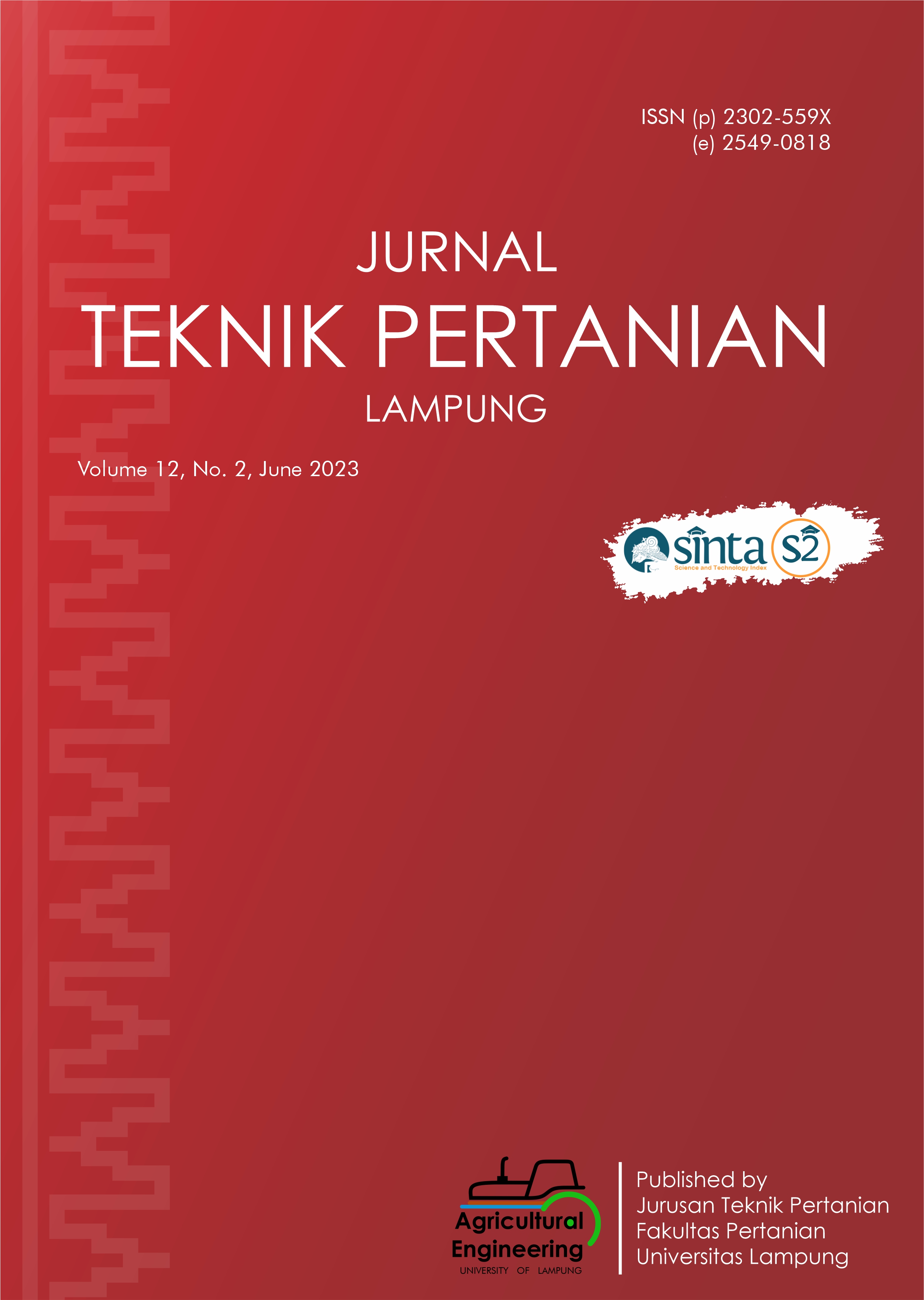Analysis of the Performance of Liquid Fertilization in Cucumber Cultivation
DOI:
https://doi.org/10.23960/jtep-l.v12i2.374-383Abstract
Liquid fertilization can be applied to cucumber plants, including using electric sprayers, electric sprayers and air blowers, and using the mist blower. The three sprayer units are capable of producing fine granules (droplets) that can enter the stomata of cucumbers. This study aims to compare the results of spraying performance using the three methods of liquid fertilization in cucumber cultivation. The research method used is indoor testing in the Sprayer Laboratory to determine the value of the performance parameters of each method of liquid fertilization and outdoor testing to apply liquid fertilizer droplets to cucumbers and determine their effect on the growth and production of cucumbers. The results showed that the first fastest appearance of the flower and the first fruit was in the treatment using electric sprayers and air blowers at 24.6 days after planting (DAP) and 31.5 DAP. This treatment also produces cucumbers with the largest diameter, length, and weight of the fruit of 2.97 cm, 26.10 cm, and 298.28 grams. The accuracy of the dose of liquid fertilization application using an electric sprayer and air blower is 63.41%, an electric sprayer of 59.56%, and the mist blower of 29.90%.
Keywords: Air blower, Droplet, Electric sprayer, Mist blower, Sprayer
References
Alex, S. (2015). Sukses Mengolah Sampah Organik Menjadi Pupuk Organik. Yogyakarta: Pustaka Baru Press.
Amin, A.R. (2015). Mengenal budidaya mentimun melalui pemanfaatan media informasi. Jupiter, 14(2), 66-71.
BPS (Badan Pusat Statistik). (2021). Produksi Tanaman Sayuran. Accessed on Januari 13, 2023. https://www.https://www.bps.go.id/indicator/55/61/1/produksi-tanaman-sayuran.html.
BSN (Badan Standardisasi Nasional). (2018). SNI 8485:2018 Alat Pemeliharaan Tanaman – Sprayer Gendong Elektrik – Syarat Mutu dan Metode Uji. Jakarta: Badan Standardisasi Nasional Indonesia.
Dharmawan, A., & Soekarno, S. (2020). Uji distribusi semprotan sprayer pestisida dengan patternator berbasis water level detector. Jurnal Teknik Pertanian Lampung, 9(2), 85-95. http://dx.doi.org/10.23960/jtep-l.v9i2.85-95
Gunawan, B. (2014). Mekanisasi Pertanian. Surabaya: Jaudar Press. 201 pp.
Hamim, H., Romadlon, Z., & Dorly, D. (2019). Perkembangan morfo-anatomi bunga, buah, dan biji nyamplung (Calophyllum inophyllum L), sebagai tanaman penghasil biodiesel. Jurnal Sumberdaya Hayati, 5(1), 1-10. https://doi.org/10.29244/jsdh.5.1.1-10
Hermawan, W. (2014). Kinerja sprayer bermotor dalam aplikasi pupuk daun di perkebunan tebu. Jurnal Keteknikan Pertanian, 26(2), 91-98.
Jamaluddin, P., Husain, S., Nunik, L., & Rizal, M. (2019). Alat dan Mesin Pertanian. Makasar: Badan Penerbit Universitas Negeri Makasar.
Jumini, J., Hasinah, H.A.R., & Armis, A. (2012). Pengaruh interval waktu pemberian pupuk organik cair enviro terhadap pertumbuhan dan hasil dua varietas mentimun (Cucumis sativus L.). Jurnal Floratek, 7, 133-140.
Karimah, N., Sugandi, W.K., Thoriq, A., & Yusuf, A. (2020). Analisis efisiensi kinerja pada aktivitas pengolahan tanah sawah secara manual dan mekanis. Jurnal Keteknikan Pertanian Tropis dan Biosistem, 8(1), 1-13. http://dx.doi.org/10.21776/ub.jkptb.2020.008.01.01
Marhaeni, A.T., Muliawati, E.S., & Arniputri, R.B. (2018). Rasio N-NO3–:P dan pengaturan kepekatan larutan nutrisi untuk pembungaan waluh berbasis hidroponik substrat. Agrotech Res J, 2(2), 69-73. https://doi.org/10.20961/agrotechresj.v2i2.22888
Prabaningrum, L. (2017). Pengaruh arah pergerakan nozzle dalam penyemprotan pestisida terhadap liputan dan distribusi butiran semprot dan efikasi pestisida pada tanaman kentang. Jurnal Hortikultura, 27(1), 113-126. https://doi.org/10.21082/jhort.v27n1. 2017.p113-126
Pramuhadi, G. (2012). Aplikasi herbisida di kebun tebu lahan kering. Jurnal Pangan, 21(2), 221-231.
Pramuhadi, G., Ibrahim, M.N.R., Haryanto, H., & Johannes, J. (2019). Studi efektivitas herbiciding gulma lahan kering pada berbagai metode pengabutan. Jurnal Teknik Pertanian Lampung, 8(1), 1-9. http://dx.doi.org/10.23960/jtep-l.v8i1.1-9
Purba, T., Situmeang, R., Rohman, H.F., Mahyati, M., Arsi, A., Firgiyanto, R., Junaedi, A.S., Saadah, T.T., Junairiah, J., Herawati, J., & Suhastyo, A.A. (2021). Pupuk dan Teknologi Pemupukan. Medan: Yayasan Kita Menulis. 150 pp.
Rahman, M.N., & Yamin, M. (2014). Modifikasi nosel pada sistem penyemprotan untuk pengendalian gulma menggunakan sprayer gendong elektrik. Jurnal Keteknikan Pertanian, 2(1), 39-46.
Sari, V.I., & Prasetio, A.D. (2021). Perbedaan penggunaan nozzle polijet dan flat fan pada kalibrasi penyemprotan knapsack sprayer. Jurnal Pertanian Presisi, 5(1), 1-12. http://dx.doi.org/10.35760/jpp.2021.v5i1.3682
Tiyandara, N.A., Oktarina, O., & Wijaya, I. (2020). Pertumbuhan dan produksi mentimun pada perbedaan konsentrasi pupuk cair, pemangkasan dan jarak tanam. Jurnal Agroqua, 18(1), 31-47. https://doi.org/10.32663/ja.v18i1.1203
Zulkarnain, Z. (2018). Budidaya Sayuran Tropis. Jakar
Downloads
Published
Issue
Section
License
- Authors who publish with this journal agree to the following terms:
- Authors retain copyright and grant the journal right of first publication with the work simultaneously licensed under a Creative Commons Attribution-ShareAlike 4.0 International Lice that allows others to share the work with an acknowledgement of the work's authorship and initial publication in this journal.
- Authors are able to enter into separate, additional contractual arrangements for the non-exclusive distribution of the journal's published version of the work (e.g., post it to an institutional repository or publish it in a book), with an acknowledgement of its initial publication in this journal.
- Authors are permitted and encouraged to post their work online (e.g., in institutional repositories or on their website) prior to and during the submission process, as it can lead to productive exchanges, as well as earlier and greater citation of published work (See The Effect of Open Access).
Jurnal Teknik Pertanian Lampung

JTEPL is licensed under a Creative Commons Attribution-ShareAlike 4.0 International License.

